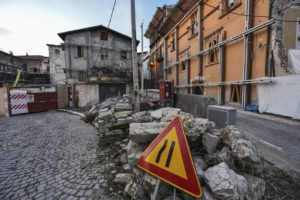A magnitude 6.2 earthquake has struck the central Italian town of Amatrice, badly damaging the town and trapping people under rubble. At least six people are reported to have lost their lives so far.

Dr Mark Quigley was a researcher and lecturer at the University of Canterbury when the 2010 and 2011 earthquakes struck Christchurch.
Now based at the University of Melbourne, he supplied the following commentary on the Italian quake and the similarities and differences with the Christchurch quakes.
Dr. Mark Quigley, Associate Professor in Active Tectonics and Geomorphology, School of Earth Sciences, The University of Melbourne, comments:
“The moment magnitude 6.2 Norcia earthquake occurred at 3:36 am local time on August 24th with an epicentre approximately 10km SE of Norcia, Italy. The size of the fault that ruptured is probably around 10 x 10 km. The maximum amount of slip on the fault will probably be about 1 meter. A surface rupture or other form of surface deformation is possible.
“Strong aftershocks will affect this region over the coming days to months. The largest aftershock from the 2009 L’Aquila earthquake was a magnitude 5.5. In some cases these aftershocks can cause more damage than the preceding larger earthquake. For every magnitude 5 aftershock, 10 magnitude 4s are expected. There will be thousands of small aftershocks throughout the region from this event, but most will go unfelt.
“This earthquake is no surprise. This is one of the most seismically active parts of Italy as clearly identified in many seismic hazard maps. During the past seven centuries, Norcia has been hit by six earthquakes that have caused very strong to severe shaking.
Quake central
“Roughly 10,000 people were killed in Norica, Montereale, L’Aquila and the encompassing Appenine region in three magnitude 6.2-6.7 earthquakes in 1703. Parts of Norcia were subsequently built upon the surface rupture created in the 1703 earthquake. Another earthquake in 1997 caused 11 fatalities.
“In this most recent event, an estimated 13,000 people would have experienced severe ground shaking that would have persisted for probably 10-20 seconds. Another 230,000 people or more would have experienced very strong shaking.
“Things like site effects (the local behaviour of different types of foundation materials to shaking, for example soils vs gravels vs rocks) will be important in influencing the patterns and severity of shaking-induced damage. The estimated damage will almost inevitably exceed $100M USD, and may exceed $1B.
Comparison with Christchurch
“Distinctly from Christchurch, where the region is being squeezed between the Pacific Ocean and the Southern Alps, this part of Italy is experiencing crustal extension; eastern central Italy is moving to the NE relative to Rome. As a result, this region experiences normal faulting earthquakes as the land is torn apart. The fault systems are short and structurally complex, so the earthquakes are not overly large by global standards (almost always < magnitude 6.8 to 7).
“But because the earthquakes are shallow and structurally complex, like the 2011 Christchurch earthquake, and because many of the local towns and cities contain vulnerable buildings, strong shaking from these earthquakes has the potential to inflict major damage and loss of life in urban areas. Furthermore, this region seems to be particularly prone to earthquake clustering, whereby periods of relative quiescence are interrupted by several strong earthquakes over timescales lasting from weeks to decades.
“My experience in the region is that there is excellent and continuously improving scientific information about the hazard here. Italy has a rich record of seismologic and paleoseismologic research. But the knowledge of the hazard has not always translated well into measures that directly reduce economic loss and fatalities in earthquakes. Numerous vulnerable buildings remain, and the recovery process is commonly plagued by long disruptions and inadequate government funding to recover rapidly. For example, when I visited L’Aquila in 2013, large parts of the city were still cordoned off, numerous buildings had not been repaired or demolished, and recovery had stagnated due largely to financial constraints.
Improving resilience
“Both the 2016 Norcia earthquake, and the 2009 L’Aquila earthquake, highlight just how important it is to translate hazard assessments into improving the resilience of infrastructure to strong shaking. The future focus in this region should remain on the science-engineering-policy interface; although this was one of the strongest aspects of the Christchurch earthquake recovery process, it has often proven to be the most challenging linkages in other settings around the globe.”